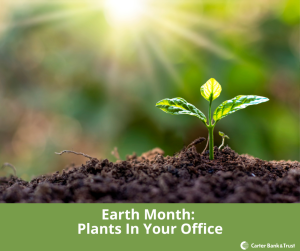Welcome to Earth Month! At Carter Bank & Trust, our Branch Workplace Service Standards promote the use of office plants to improve both the appearance and air quality of our branches. To help you get started with your own office plants, we’ve put together some tips and tricks (and what to avoid) to help you create a beautiful and healthy office environment.

Best Plant Practices
Adding plants to your office environment not only improves air quality, but it also creates a more attractive and welcoming atmosphere. When selecting plants, choose those that are non-toxic, slow-growing, and easy to maintain. Regular pruning and shaping will help to avoid overgrowth and maintain a neat appearance.
When choosing containers, select ones that are attractive and made of durable materials such as ceramic or clay. Use water catcher trays made from felt or corkboard to avoid water damage to desks and floors. Avoid plants with high fragrances that may cause allergies or fragrance sensitivities.
Selecting the Right Plant
When selecting plants for your office, consider low-maintenance options with low to medium light requirements. Slow growers are also a good choice, and ensure that the size of the plant is proportional to the space available. Avoid placing plants in areas where they may be easily knocked over or brushed against.
Here are some examples of easy-care plants that are perfect for the office:
– Peace Lily: Dramatic when thirsty, but easy to care for.
– Prayer Plants (Marantas): Easy to propagate and will go dormant if not watered.
– Hurricane Fern (Asplendium): Part of the bird’s nest fern family and easy to maintain.
– Ponytail Palm (Beaucarnea Recurvate): Requires a sunny window but is hardy and cheerful.
– Spider Plant (Chlorophytum Comosum): Easy to propagate and perfect for hiding cords.
– Peperomia (Radiator Plant, Baby Rubber Plant, Watermelon Begonia): Slow-growing and forgiving.
– Chinese Evergreen (Agalonema): Easy to care for and adds a touch of green.
– Snake Plant (formerly Sanseviera now Dracaena): Easy to care for and produces “pups” near the mother plant.
Containers
When it comes to containers, choose sturdy saucers made of plastic or clay. For larger pots, use a plate (such as melamine or Corelle). Place plants in nursery pots and then place them in decorative pots to make it easy to swap out plants and to take them out to water. Use wick and grow pots as a secondary measure, and water from the top as well.
Watering
Most plants will be fine being watered every 1-2 weeks. Stick your finger into the top of the soil, and if it’s dry, water the plant. Prayer plants and peace lilies need watering once a week. Take smaller plants into the kitchen, place them in the sink, and shower them with a hand sprayer to raise humidity, keep the leaves clean, and rinse off pests. Try adding water beads or water gems to the soil to hold water.
Placement
Use plants to redirect and add life and cheer to seldom-used desks and hotel offices. Avoid blocking security cameras and sightlines within the branch or through the windows. Use plants in place of “next window” signs to add a touch of green.
Pests
The main issue with pests is usually fungus gnats. These tiny gnats are harmless but annoying and grow in soil that is too damp. Allow the soil to dry between watering, and treat with pest spray designated for indoor plants.
Conclusion
Adding office plants to your workspace is an easy and affordable way to improve air quality and create a more attractive and welcoming environment. Remember to choose easy-care plants, use sturdy containers, water regularly, and place them in appropriate areas. Happy Earth Month!
